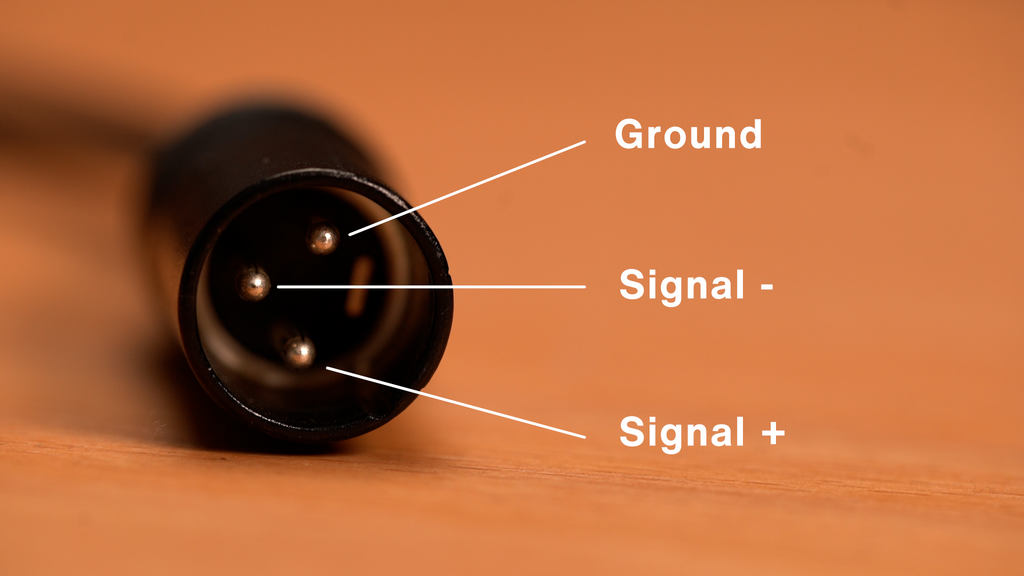
Blog
True love for great sound unites us.
Blog
True love for great sound unites us.
You can find XLR cables and connectors on many professional audio devices, including all types of microphones for recording and stage use.

When someone asks, why should you use XLR, two things immediately come to mind. First, they are capable of carrying the 48 Volt phantom power that's needed to power condenser microphones. The second thing which comes to mind, is that they are so-called balanced cables.
The balanced wiring allows us to cancel out interference that is being picked up along the way.
Let’s checkout how this works!
If you prefer to watch a video, watch the video version of this blog below.
Here we have an instrument cable that you can use, let’s say to connect your guitar to a guitar amp. It’s the perfect example of an unbalanced cable. Each wire inside the cable has its own contact point. One is for the signal, one is for ground.

In the case of an unbalanced instrument cable, it’s the tip and the sleeve. That’s why we also call them TS cables.
An XLR cable is a balanced cable.
A balanced cable has three wires and contact points.
Pin 1 is the ground wire and Pin 2 and 3 are for the signal. Two and three both carry a copy of the signal, but with reversed polarity.

Why? Now here comes the cool thing. What happens when you sum two signals with reversed polarity? The signals are cancelled out. Just like if you would combine +1 and –1, it would equal zero. And that’s exactly what happens, but only to the interference that’s introduced along the way.
The audio gear on the receiving end flips the polarity in order to leave the original signal intact, cancelling out any electrical interference. That's the great thing about XLR cables.

XLR connectors have another advantage.... they have a nifty little latch. The latch on the XLR connector is great, it prevents accidental unplugging. Here is also another thing you should know when using your XLR cables.
Never run an XLR cable parallel to a power cord (Power cord 🤘). Doing so might give you a nasty hum around 50 or 60 Hz.
We constantly receive messages from people asking us, what makes a good XLR cable?
A good cable is the one that fits your purpose.
Here are three easy things you should keep in mind when choosing an XLR cable.
First, and we can’t stress this enough, make sure the connectors are not the cheapest 💩 you can find. You can have a great cable but if the connectors suck, you won’t have a reliable relationship with your cable. And we all want something to rely on.
Second, make sure that your cable length is suitable for your recording purpose. If you’re recording at home, you’ll most likely need 3 meters maximum. Trust me, if your cables are too long, things might get messy quickly.
Lastly, you don’t have to buy the most expensive cables in the store. They won’t sound better. You could even say, some cable products are a total scam. If you want proof, get your friend to set up a blind test for you and let us know if you can actually consistently hear a difference.
You can also learn more about this topic on our blog "What's the best cable for audio?"
You might have noticed that X-L-R looks like an abbreviation, but what does it stand for?
Here are some of the contenders:
What’s your guess?
Some of these answers really make sense, especially the last one. But according to the Audio Engineering Society, it’s actually:
a registered trademark of ITT-Cannon in 1958. The original model number series for Cannon's 3-pin circular connectors - invented by them - now an industry generic term. [...] The problem was, it had no latch. Cannon rearranged the pins and added a latch, and the XL (X series with Latch) was born. Later Cannon modified the female end to put the contacts in a resilient rubber compound. They called this new version the XLR series.
Now that’s a great pickup line.
Full text here: https://www.aes.org/par/c/#XLR
If you have any further questions, you can contact us any time. We're always happy to help and eager to learn.
If you want to learn even more about microphones, check out other interesting topics on the microphone basics page!
Our best selling XLR microphones